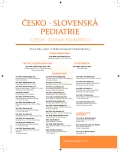Cervical lymphadenopathy from the perspective of an otolaryngologist
Authors:
K. Sobotková
Authors‘ workplace:
Klinika dětské otorinolaryngologie LF MU a FN Brno, Lékařská fakulta Masarykovy univerzity, Brno
přednosta prof. MUDr. I. Šlapák, CSc.
Published in:
Čes-slov Pediat 2015; 70 (3): 166-173.
Category:
Reviews
Overview
By using the term cervical lymphadenopathy (CL) we describe the pathological changes in terms of size, shape, structure, or clustering of lymph nodes in the neck region. These changes may or may not be accompanied by further symptoms. Inflammatory and malignant lesions in the area of head and neck are the most common causes of CL. In children, infectious causes by far prevail over other etiology and and they are also a very frequent reason for pediatricians' visits.
Although the region of neck is a matter of otorhinolaryngology (ENT), primary care of a child's patient with CL is work for pediatrician. This one should be able to perform a basic diagnostic-therapeutic procedures.
The correct diagnostics and subsequently an adequately chosen therapy requires basic conditions.1) The basic knowledge of clinical anatomy, physiology, pathophysiology of lymphatic system. 2) Doctor's general knowledge in differential diagnostics, for one thing within the illness of lymph nodes but also concerning other diseases, which can be presented as swelling in the neck region. 3) The knowledge of diagnostic-therapeutic possibilities and procedures.
Key words:
cervical lymphadenopathy, lymph node, children, differential diagnostics, diagnostic-therapeutic procedures
Sources
1. Ferlito A. Classification of neck dissections: An evolving system. Auris Nasus Larynx 2009; 36 (2): 127–134.
2. Čelakovský P, Plzák J, Betka J, et al. Krční metastázy. Anatomie krku ve vztahu k blokovým krčním disekcím. 1. vyd. Havlíčkův Brod: Tobiáš, 2012 : 18–37.
3. Vyhnánková L. Diferenciální diagnostika krčních lymfadenitid u dětí. Pediatr pro Praxi 2009; 10 (6): 361–363.
4. Čelakovský P, Plzák J, Betka J, et al. Krční metastázy. Klinické vyšetření při podezření na nádorové postižení krčních uzlin. 1. vyd. Havlíčkův Brod: Tobiáš, 2012 : 58.
5. Hozáková L, Rožnovský L, Bílková Fránková H. Felinóza – stále aktuální zoonóza. Klin Mikrobiol Inf Lék 2014; 20 (1): 4–10.
6. Carvalho A, Codecasa L, Pinsi G, et al. Differential diagnosis of cervical mycobacterial lymphadenitis in children. Pediatr Infect Dis J 2010; 29 (7): 629–633.
7. Peridis S, Koudoumnakis E, Theodoridis A, et al. Surgical outcomes and histology findings after tonsillectomy in children with periodic fever, aphthous stomatitis, pharyngitis, and cervical adenitis syndrome. Am J Otolaryngol 2010; 31 : 472–475.
8. Valenzuela PM, Araya A, Pérez CI, et al. Profile of inflammatory mediators in tonsils of patients with periodic fever, aphthous stomatitis, pharyngitis, and cervical adenitis (PFAPA) syndrome. Clin Rheumatol 2013; 32 : 1743–1749.
9. Galanakis E, Papadakis CE, Giannoussi E, et al. PFAPA syndrome in children evaluated for tonsillectomy. Arch Dis Child 2002; 86 : 434–435.
10. Roh JL, Huh J, Moon HN. Lymphomas of the head and neck in the pediatric population. Int J Pediatr Otorhinolaryngol 2007; 71 : 1471–1477.
11. Jamal N, Ahmed S, Miller T, et al. Doxycycline sclerotherapy for pediatric head and neck macrocystic lymphatic malformations: A case series and rewiev of the literature. Int J Pediatr Otorhinolaryngol 2012; 76 : 1127–1131.
12. Burrows PE, Mitri RK, Alomari A, et al. Percutaneous sclerotherapy of lymphatic malformations with doxycycline. Lymphat Res Biol 2008; 6 (3–4): 209–216.
13. Motz KM, Nickley KB, Bedwell JR, et al. OK432 versus doxycycline for treatment of macrocystic lymphatic malformations. Ann Otol Rhinol Laryngol 2014; 123 (2): 81–88.
Labels
Neonatology Paediatrics General practitioner for children and adolescentsArticle was published in
Czech-Slovak Pediatrics

2015 Issue 3
- What Effect Can Be Expected from Limosilactobacillus reuteri in Mucositis and Peri-Implantitis?
- The Importance of Limosilactobacillus reuteri in Administration to Diabetics with Gingivitis
Most read in this issue
- Cervical lymphadenopathy from the perspective of an otolaryngologist
- Mild mental retardation in ambulance of general practitioner for child and adolescent – can you recognize it?
- Segmental dilatation of the intestine – case series of newborns with segmental dilatation of the small intestine and a literature review
- Preparticipation examination in young athletes with focus on resting electrocardiogram
